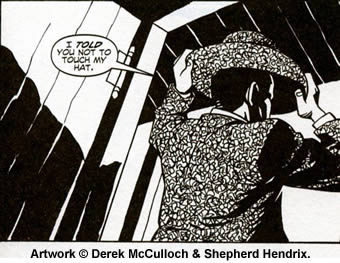 Less than two years after that story appeared, Shakur was shot dead. He was leaving September 1996's Mike Tyson/Bruce Seldon fight in Las Vegas when a car pulled up next to his on the street and pumped 13 rounds inside. No-one's ever been caught for the crime, but police believe members of Los Angeles' Southside Crips were responsible. Biggie Smalls, the LA rapper who Shakur had always believed was behind the New York shooting, was killed in a drive-by six months later.
Less than two years after that story appeared, Shakur was shot dead. He was leaving September 1996's Mike Tyson/Bruce Seldon fight in Las Vegas when a car pulled up next to his on the street and pumped 13 rounds inside. No-one's ever been caught for the crime, but police believe members of Los Angeles' Southside Crips were responsible. Biggie Smalls, the LA rapper who Shakur had always believed was behind the New York shooting, was killed in a drive-by six months later.
We're still waiting for the definitive gangsta rap take on Stag's own story, but that's not to say that rap has ignored him altogether. A St Petersburg rock combo called Billy's Band recently produced a rap of Nick Cave's Stagger Lee. It's full of thunderous drums and rapped with a strong Russian accent. “This is the way things are going in the 'hood,” singer Billy Novik warns us. “It's just no damn good, hanging out in the 'hood”. No doubt today's gangster-ridden Russia can match anything thrown up by St Louis in 1895, so perhaps this version is less of a cultural oddity than it seems.
We've come a long way from Mississippi John Hurt's sober and saddened account of the damage Stagger Lee does to those around him. Each successive generation that takes on the song has darkened it, stepped a little more keenly into the killer's shoes and cast aside aside another scrap of whatever pity remains for Billy.
But, for Cave, it's the sheer sadism of versions like his that makes them so exhilarating. “What I like about it is that Stagger Lee's atrocious behaviour has nothing to do with anything but flat-out meanness,” he told Mojo. “I like the way the simple, almost naïve, traditional murder ballad has gradually become a vehicle that can happily accommodate the most twisted acts of deranged machismo. Just like Stagger Lee himself, there seems to be no limits to how evil this song can become.”

Sources
1: Physical Growth of the City of St Louis, stlouis.missouiri.org/heritage/History69
2: A Book About Myself, by Theodore Dreiser (Constable, 1929).
3: St Louis Post-Dispatch, 21/2/1891.
4: Stagolee Shot Billy, by Cecil Brown (Harvard University Press, 2003). Brown's book remains the definitive history of Stagger Lee, and is highly recommended to anyone with an interest in the song.
5: Memphis Down in Dixie, by Shields McIlwaine (EP Dutton, 1948).
6: Original Stack O'Lee Blues, by Long Cleve Reed & Little Harvey Hull - The Down Home Boys. (Black Patti, 1927).
7: Stack O'Lee, by Mississippi John Hurt (Okeh, 1928).
8. Stagger Lee, by Derek McCulloch & Shepherd Hendrix (Image Comics 1996).
9: St Louis Globe-Democrat, 12/9/1902.
10: St Louis Star-Sayings, 29/12/1895.
11: St Louis Post Dispatch, 17/3/1911.
12: St Louis Globe-Democrat, 28/12/1895.
13: St Louis Globe-Democrat, 14/7/1896.
14: Badman Stackolee, by The Chas McDevitt Skiffle Group [Trad. Arr: McDevitt] (Oriole, 1957).
15: Stagger Lee, by Lloyd Price [Lloyd Price & Harold Logan] (HMV, 1959).
16: The Comics Journal, February 2003.
17: NME, 15/12/1979.
18: Wrong 'Em Boyo, by The Clash [Clive Alphanso, MCPS] (CBS, 1979).
19: Tragedy in Ragtime: Black Folktales From St Louis, by John R. David. (St Louis University, 1976).
20: Stack-O-Lee, by Tennessee Ernie Ford [Trad. Arr: Joe “Fingers” Carr] (Capitol, 1950).
21: Stack-A-Lee, by Dr John [Trad. Arr: Archibald] (Atlantic, 1972).
22: “A Treasury of American Folklore: Stories, Ballads and Traditions of the People”, by BA Botkin (New York, 1945).
23: Life: The Lore and Folk Poetry of the Black Hustler, by Dennis Wepman (University of Pennsylvania Press, 1976).
24: Mojo, January 1996.
25: Nuthin' But A “G” Thang, by Eithne Quinn (Columbia University Press, 2004).
26: Mystery Train, by Greil Marcus (Faber & Faber, 1975).
27: NME, 17/12/1994.
28: http://en.wikipedia.org/wiki/British_Bulldog_revolver